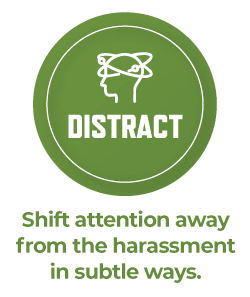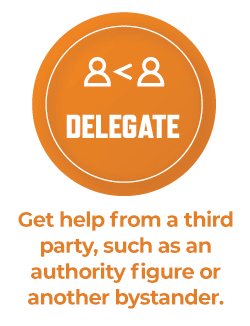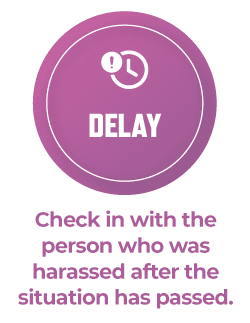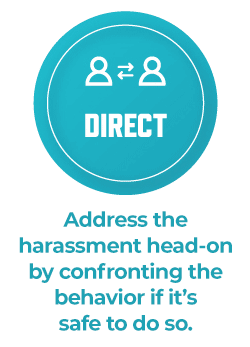Small Actions, Big Impact: The 5Ds of Bystander Intervention
How to Intervene and Make Communities Safer with Steps to Hope
In a world where harassment and hate still occur far too often, one of the worst experiences for someone targeted by such behavior is the silence of bystanders who fail to act. When others look away or ignore the situation, it amplifies the trauma of the person being harassed. But it doesn’t have to be this way.
At Steps to Hope, we believe that everyone has the power to create safer, more supportive communities. By standing up, speaking out, and taking action, we can challenge harassment and make a meaningful difference. Through a simple framework called the 5Ds of bystander intervention—Distract, Delegate, Document, Delay, and Direct—we can all learn how to intervene safely and effectively. Together, with Steps to Hope leading the charge, we can replace a culture of harassment with one of care and humanity.
The 5Ds of Bystander Intervention
Steps to Hope champions the 5Ds of bystander intervention as practical and accessible tools for anyone to help stop harassment and support those targeted. These methods—Distract, Delegate, Delay, Direct, and Document—offer different approaches to safely intervene and make a difference. Each strategy can be tailored to the situation, ensuring that bystanders can act without escalating the conflict.
Distract: Shift attention away from the harassment in subtle ways.
Delegate: Get help from a third party, such as an authority figure or another bystander.
Delay: Check in with the person who was harassed after the situation has passed.
Direct: Address the harassment head-on by confronting the behavior if it’s safe to do so.
Document: Record or take notes about the incident, but always with the victim’s consent.
Each of the 5Ds is rooted in Steps to Hope’s mission to foster kindness, safety, and respect in every community. Let’s explore each method in more detail to see how they can make an impact.
The Distract method is a subtle yet powerful way to intervene without confronting the harasser directly. By redirecting attention, you can interrupt the harmful behavior and provide relief to the person being targeted.
Here are some examples of how to Distract:
Pretend to know the person being harassed. Say something like, Hey, isn’t it funny running into you here? How’s your day been?
Create a diversion by accidentally spilling a drink or dropping your belongings to draw attention away from the harassment.
Ask the person being harassed for directions, the time, or any other unrelated question to break the moment.
These tactics can be especially helpful in situations where directly addressing the harassment feels unsafe or likely to escalate. Steps to Hope encourages this creative approach to protect both bystanders and victims while disrupting harmful behavior.
When you don’t feel equipped to intervene on your own, the Delegate method allows you to enlist help from others. This could include nearby bystanders, someone in a position of authority, or others better positioned to assist.
Here’s how to Delegate effectively:
Speak to someone nearby: That person is making them uncomfortable. Can you help me step in or distract them?
Seek out someone with authority, like a store manager, bus driver, or teacher, and explain the situation clearly.
Work as a team with other bystanders to decide the best course of action.
Steps to Hope emphasizes that Delegating is about sharing responsibility to keep everyone safer, ensuring that support is available without putting yourself or others at greater risk.
If the situation unfolds too quickly to intervene in the moment, the Delay method allows you to provide support afterward. Following up with someone who has been harassed can significantly reduce their feelings of isolation and trauma.
Ways to Delay include:
Asking the person if they’re okay and letting them know you saw what happened.
Offering to accompany them somewhere safe or sitting with them for a while.
Providing resources or offering to help them file a report, if they want to.
Steps to Hope understands that even small gestures of care can have a lasting impact. By showing support after the fact, you’re helping to rebuild a sense of safety and community for the person who was harmed.
The Direct method involves addressing the harassment head-on by speaking to the person responsible. While this approach can be effective, it requires caution to ensure that the situation doesn’t escalate or put anyone in danger.
Before choosing this method, ask yourself:
Am I physically safe?
Is the person being harassed safe?
Is the situation unlikely to escalate?
Does the person being harassed want someone to speak up?
If it feels safe to proceed, keep your response clear and concise. For example:
That’s not okay.
Leave them alone.
They’ve asked you to stop, and I’m here to support them.
Steps to Hope reminds us that Direct intervention isn’t always the right choice, but when used appropriately, it can be a powerful way to stand against harassment and affirm your support for the person being targeted.
The Document method involves recording or taking notes about an incident of harassment. However, documentation should always be done with care and respect for the person being targeted. It’s crucial to focus on their needs and get their consent before sharing anything.
Best practices for Documentation include:
Start recording only if someone else is already assisting the person being harassed and the situation feels safe to do so.
Never post or share recordings without the explicit permission of the person affected.
If asked, provide the documentation to the person targeted so they can decide how to use it.
Steps to Hope advocates for using this method responsibly, ensuring that the person’s dignity and autonomy are respected while providing valuable evidence if they choose to take further action.
Together, these five strategies empower individuals to take action while prioritizing safety and respect.
When you choose to intervene—whether through Distraction, Delegation, Documentation, Delay, or Direct action—you’re contributing to a culture of accountability and care. Steps to Hope is here to equip you with the tools and confidence to make a difference.
Harassment and hate don’t have to be part of our daily reality. By learning and applying the 5Ds of bystander intervention, each of us has the power to create positive change. Every small action chips away at a culture of silence and replaces it with one of safety and compassion.
At Steps to Hope, we’re committed to supporting individuals in their journey to become active, empowered bystanders. Together, we can foster stronger, safer, and more inclusive communities. Join us today—because every step toward hope matters.






